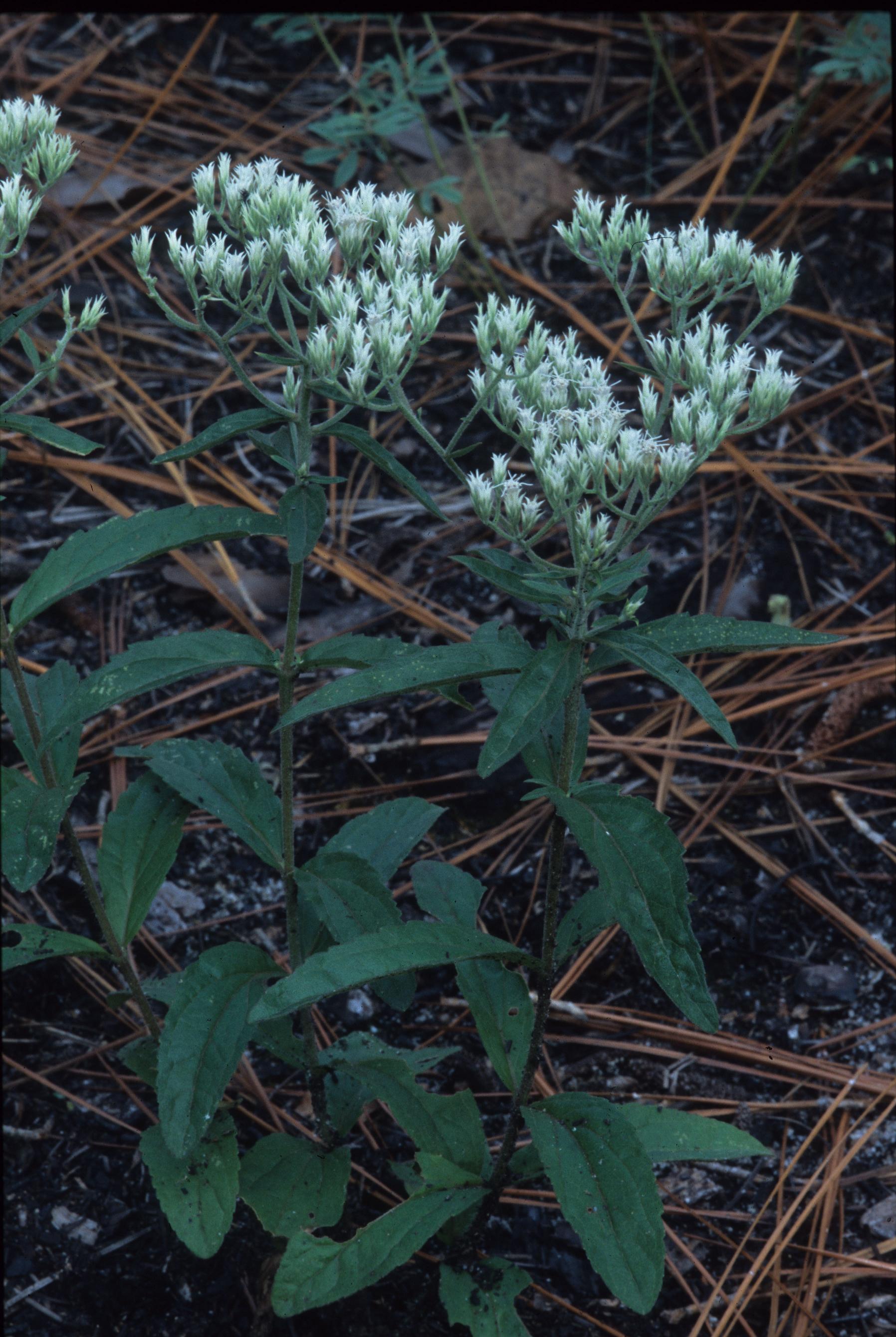Difference between revisions of "Eupatorium album"
(→Description) |
|||
| Line 24: | Line 24: | ||
==Ecology== | ==Ecology== | ||
===Habitat=== <!--Natural communities, human disturbed habitats, topography, hydrology, soils, light, fire regime requirements for removal of competition, etc.--> | ===Habitat=== <!--Natural communities, human disturbed habitats, topography, hydrology, soils, light, fire regime requirements for removal of competition, etc.--> | ||
| + | It is found in sandhills, Longleaf pine-wiregrass savannas, evergreen scrub oak sand ridges, pine flatwoods, old fields, flatwoods, hammocks, seepage slopes, pine-palmetto flatwoods, in woods adjacent to sinkholes, and in well-drained Longleaf pinelands (FSU Herbarium). It is also found in human disturbed areas such as roadsides, areas that have been clear cut, clobbered, bulldozed, and in powerline corridors (FSU Herbarium). it requires open to semi-shaded areas (FSU Herbarium). It is associated with areas that have drying-loamy sand, wet-sandy loam, dry sand, gray-sand loam, dry-sparsely loamy sand soil types (FSU Herbarium). | ||
| + | |||
| + | |||
It does well in open canopy areas on longleaf pine habitats and does okay in areas that have been clear cut.<ref>Brockway, D. G. and C. E. Lewis (2003). "Influence of deer, cattle grazing and timber harvest on plant species diversity in a longleaf pine bluestem ecosystem." Forest Ecology and Management 175: 49-69.</ref> | It does well in open canopy areas on longleaf pine habitats and does okay in areas that have been clear cut.<ref>Brockway, D. G. and C. E. Lewis (2003). "Influence of deer, cattle grazing and timber harvest on plant species diversity in a longleaf pine bluestem ecosystem." Forest Ecology and Management 175: 49-69.</ref> | ||
It is found in longleaf pine sandhill communities.<ref>Heuberger, K. A. and F. E. Putz (2003). "Fire in the suburbs: ecological impacts of prescribed fire in small remnants of longleaf pine (Pinus palustris) sandhill." Restoration Ecology 11: 72-81.</ref> | It is found in longleaf pine sandhill communities.<ref>Heuberger, K. A. and F. E. Putz (2003). "Fire in the suburbs: ecological impacts of prescribed fire in small remnants of longleaf pine (Pinus palustris) sandhill." Restoration Ecology 11: 72-81.</ref> | ||
| + | |||
===Phenology=== <!--Timing off flowering, fruiting, seed dispersal, and environmental triggers. Cite PanFlora website if appropriate: http://www.gilnelson.com/PanFlora/ --> | ===Phenology=== <!--Timing off flowering, fruiting, seed dispersal, and environmental triggers. Cite PanFlora website if appropriate: http://www.gilnelson.com/PanFlora/ --> | ||
===Seed dispersal=== | ===Seed dispersal=== | ||
Revision as of 15:17, 13 July 2015
| Eupatorium album | |
|---|---|

| |
| Photo was taken by Gil Nelson | |
| Scientific classification | |
| Kingdom: | Plantae |
| Division: | Magnoliophyta - Flowering plants |
| Class: | Magnoliopsida – Dicotyledons |
| Order: | Asterales |
| Family: | Asteraceae ⁄ Compositae |
| Genus: | Eupatorium |
| Species: | E. album |
| Binomial name | |
| Eupatorium album L. | |

| |
| Natural range of Eupatorium album from USDA NRCS Plants Database. | |
Contents
Description
Common Name: White thoroughwort
Distribution
Ecology
Habitat
It is found in sandhills, Longleaf pine-wiregrass savannas, evergreen scrub oak sand ridges, pine flatwoods, old fields, flatwoods, hammocks, seepage slopes, pine-palmetto flatwoods, in woods adjacent to sinkholes, and in well-drained Longleaf pinelands (FSU Herbarium). It is also found in human disturbed areas such as roadsides, areas that have been clear cut, clobbered, bulldozed, and in powerline corridors (FSU Herbarium). it requires open to semi-shaded areas (FSU Herbarium). It is associated with areas that have drying-loamy sand, wet-sandy loam, dry sand, gray-sand loam, dry-sparsely loamy sand soil types (FSU Herbarium).
It does well in open canopy areas on longleaf pine habitats and does okay in areas that have been clear cut.[1]
It is found in longleaf pine sandhill communities.[2]
Phenology
Seed dispersal
Seed bank and germination
Fire ecology
It flowers within three months of burning in the early spring to early summer.KMR
Pollination
Use by animals
Diseases and parasites
Conservation and Management
Cultivation and restoration
Photo Gallery
References and notes
- ↑ Brockway, D. G. and C. E. Lewis (2003). "Influence of deer, cattle grazing and timber harvest on plant species diversity in a longleaf pine bluestem ecosystem." Forest Ecology and Management 175: 49-69.
- ↑ Heuberger, K. A. and F. E. Putz (2003). "Fire in the suburbs: ecological impacts of prescribed fire in small remnants of longleaf pine (Pinus palustris) sandhill." Restoration Ecology 11: 72-81.